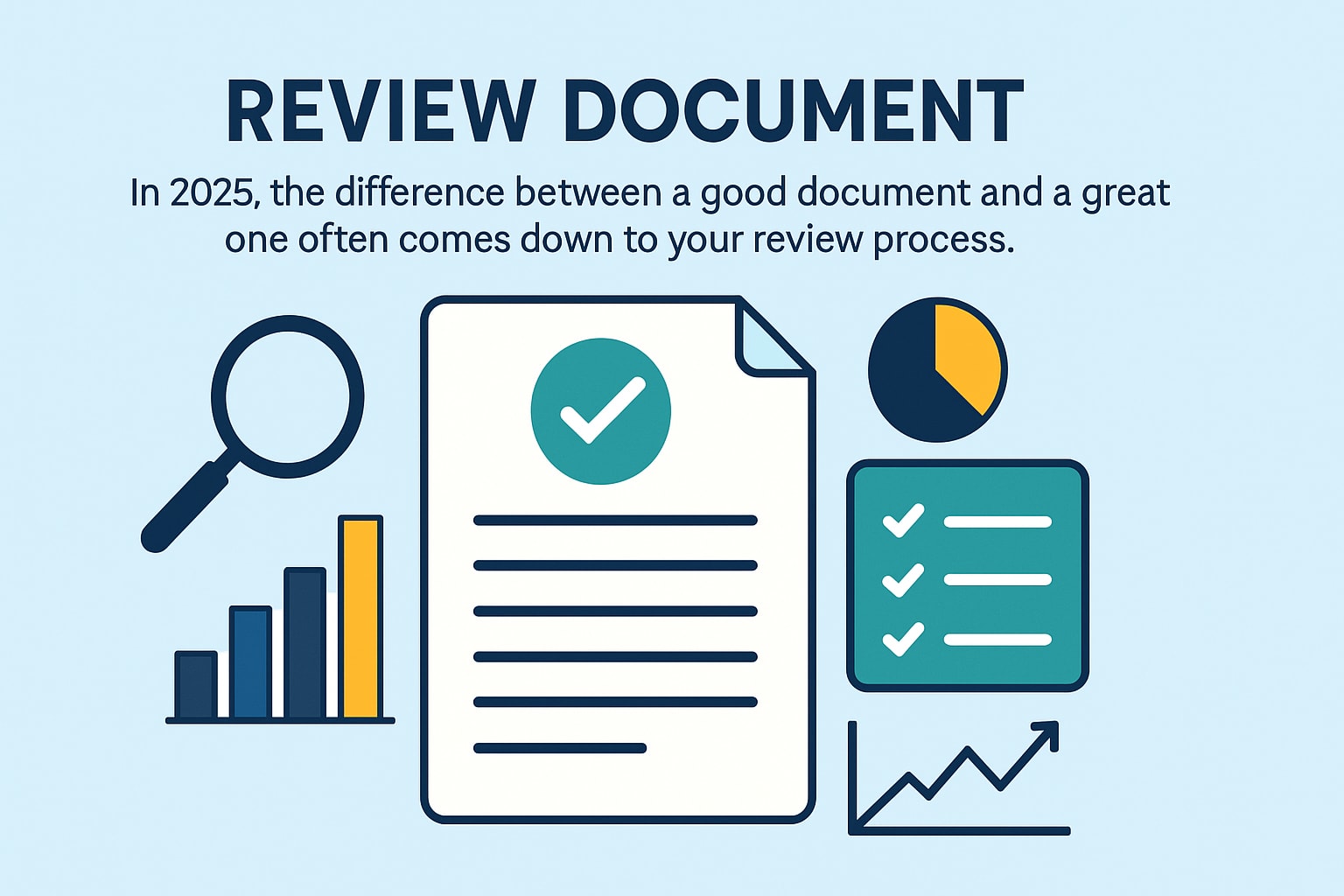In 2025, the difference between a good document and a great one often comes down to your review document process. Outdated methods can put your organization at risk, leading to compliance failures, costly errors, and miscommunication that damages trust.
Today’s digital landscape is evolving rapidly, with new trends and technologies redefining how teams approach the review document workflow. Embracing these changes means improved efficiency, fewer mistakes, and stronger collaboration across every project.
This guide delivers the essential best practices you need to review document workflows with confidence. Take action now to optimize your process and ensure your documents are accurate, compliant, and clear—every time.
Understanding Document Review: Purpose and Importance
Defining Document Review in 2025
A review document today is more than a simple check for typos or formatting. In 2025, it is a multi-stage, stakeholder-driven process designed to ensure accuracy, clarity, and compliance. Teams rely on a layered approach, where drafts are assessed by writers, peers, subject matter experts, and compliance officers.
Modern review document workflows increasingly leverage AI and automation. These tools help flag inconsistencies, suggest edits, and verify compliance in real time. For example, legal and technical documents now routinely pass through several levels of scrutiny before approval. Over 70% of organizations require this multi-stage review to meet compliance standards.
Why Document Review Matters More Than Ever
The necessity to review document content thoroughly has never been higher. Regulatory frameworks like GDPR and CCPA demand strict adherence, while industry-specific mandates continue to evolve. A single oversight in a review document can lead to legal, financial, or reputational damage.
Brand reputation is also at stake. For example, Microsoft’s terms of service reportedly take more than an hour to read, highlighting the importance of plain language for consumer trust. Mistakes can erode credibility, and Document review and buyer trust signals shows how compliance and clarity directly influence user confidence. The cost of errors is simply too high to ignore.
Types of Documents Requiring Rigorous Review
Not every review document is created equal. Some require more scrutiny due to content or audience. Technical manuals, legal contracts, company policies, and marketing materials all need detailed review. Internal documents, like training guides, focus on accuracy and clarity for staff, while external documents, such as customer-facing user guides, must meet branding and regulatory standards.
| Document Type | Internal Use | External Use |
|---|---|---|
| Technical Manual | Staff training | Customer support |
| Legal Contract | HR, Operations | Client agreements |
| Policy Document | Compliance teams | Public disclosure |
| Marketing Material | Campaign review | Public campaigns |
Tailoring the review document process to each type is essential.
Key Outcomes of Effective Review
An effective review document process delivers measurable results. First, it improves accuracy and reduces costly errors. Second, it enhances readability, making content accessible and easy to understand—readability metrics like Flesch Reading Ease are now standard.
Third, a robust review document approach ensures compliance with legal and regulatory requirements, protecting the organization from risk. Finally, stakeholders gain confidence in the process, leading to faster approvals and smoother workflows. The right review document strategy ultimately accelerates business success.
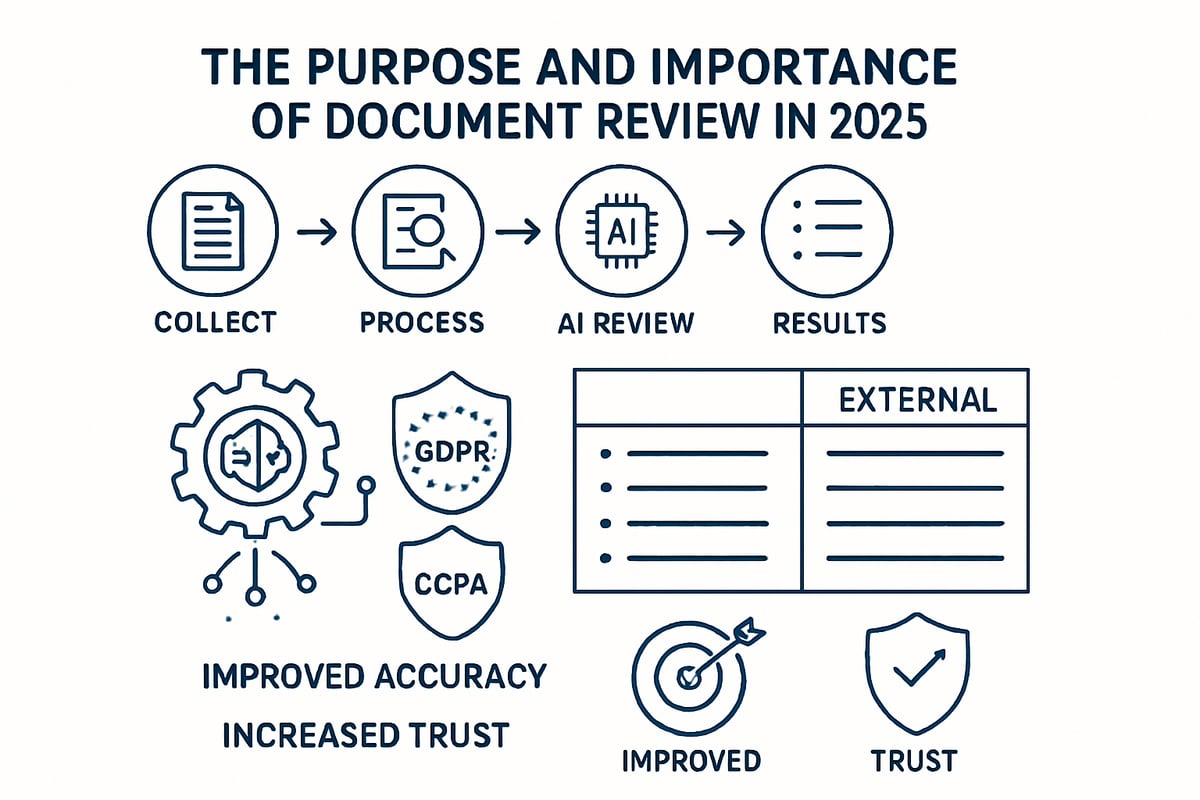
Core Stages of the Document Review Process
A robust review document workflow is the backbone of modern content quality and compliance. Each stage is designed to catch errors, ensure clarity, and guarantee that every review document meets organizational standards. Let's break down the core stages shaping effective document review in 2025.
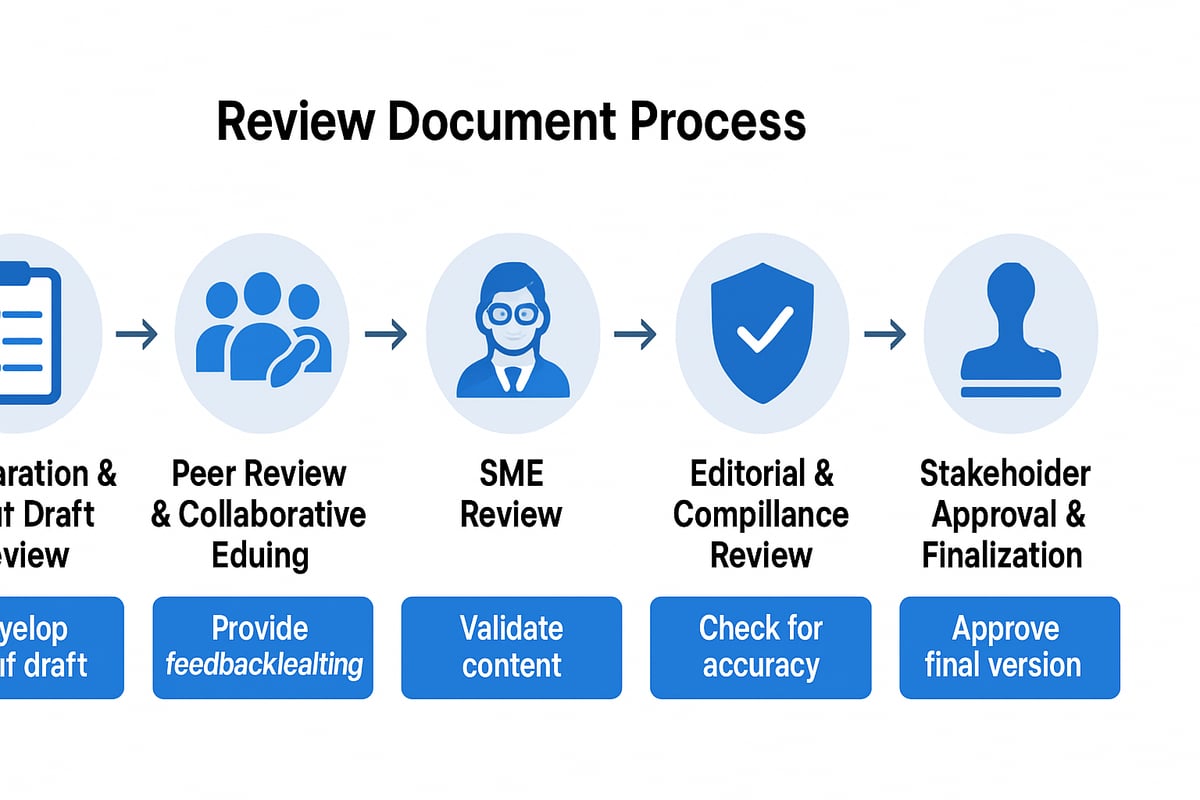
Step 1: Preparation and Initial Draft Review
The first stage in the review document process begins with thorough preparation. Gather all relevant source materials, background context, and reference documents before drafting.
Before the formal review document cycle starts, ensure the draft is complete and internally consistent. Using a detailed checklist for self-assessment can help writers spot missing sections or unclear points early. Version control is crucial at this step to track changes and maintain a single source of truth. By starting strong, you lay the groundwork for a smooth multi-stage review document journey.
Step 2: Peer Review and Collaborative Editing
Next, the review document moves into peer review and collaborative editing. Involving colleagues or subject matter peers provides a fresh perspective, allowing you to identify logical inconsistencies, content gaps, or unclear instructions.
For example, in SaaS documentation, peer review is essential for catching technical inaccuracies that a single writer might miss. Real-time collaboration tools such as Google Docs or Document360 streamline this process, letting multiple reviewers comment, suggest edits, and resolve issues simultaneously. This step ensures the review document is accurate and understandable before specialist input.
Step 3: Subject Matter Expert (SME) Review
At this stage, the review document is evaluated by subject matter experts. SMEs validate technical or specialized content, ensuring all information is factually correct and up to date.
For instance, a developer's review of API documentation can uncover technical gaps or outdated references that would otherwise go unnoticed. Integrating SME feedback is a best practice—collate comments, resolve conflicting input, and document changes. This targeted scrutiny makes the review document robust and reliable for its intended audience.
Step 4: Editorial and Compliance Review
Editorial and compliance review is where the review document is polished to meet tone, style, and regulatory requirements. Senior editors check for grammar, consistency, and overall structure, while compliance officers ensure alignment with standards like GDPR or CCPA.
For example, legal teams might review privacy policies for plain language and regulatory adherence. Style guides and compliance checklists are essential tools here. To further optimize this stage, consider external resources like Document Review Best Practices: Top Strategies for 2025, which outlines proven methods to streamline your review document process, reduce errors, and improve compliance outcomes.
Step 5: Stakeholder Approval and Finalization
The final step in the review document process is obtaining sign-off from key stakeholders such as legal, marketing, or executive leadership. This stage involves final checks for formatting, accessibility, and completeness—ensuring the review document is ready for publication or distribution.
Enterprise content management systems often support approval workflows, helping teams track progress and maintain accountability. A comprehensive review document process at this stage results in faster approvals, fewer revisions, and higher stakeholder confidence.
Best Practices for Effective Document Review in 2025
Optimizing your review document process in 2025 means more than just catching typos. It’s about building a workflow that ensures accuracy, efficiency, and compliance—every single time. Let’s break down the essential best practices to future-proof your document review and boost results.
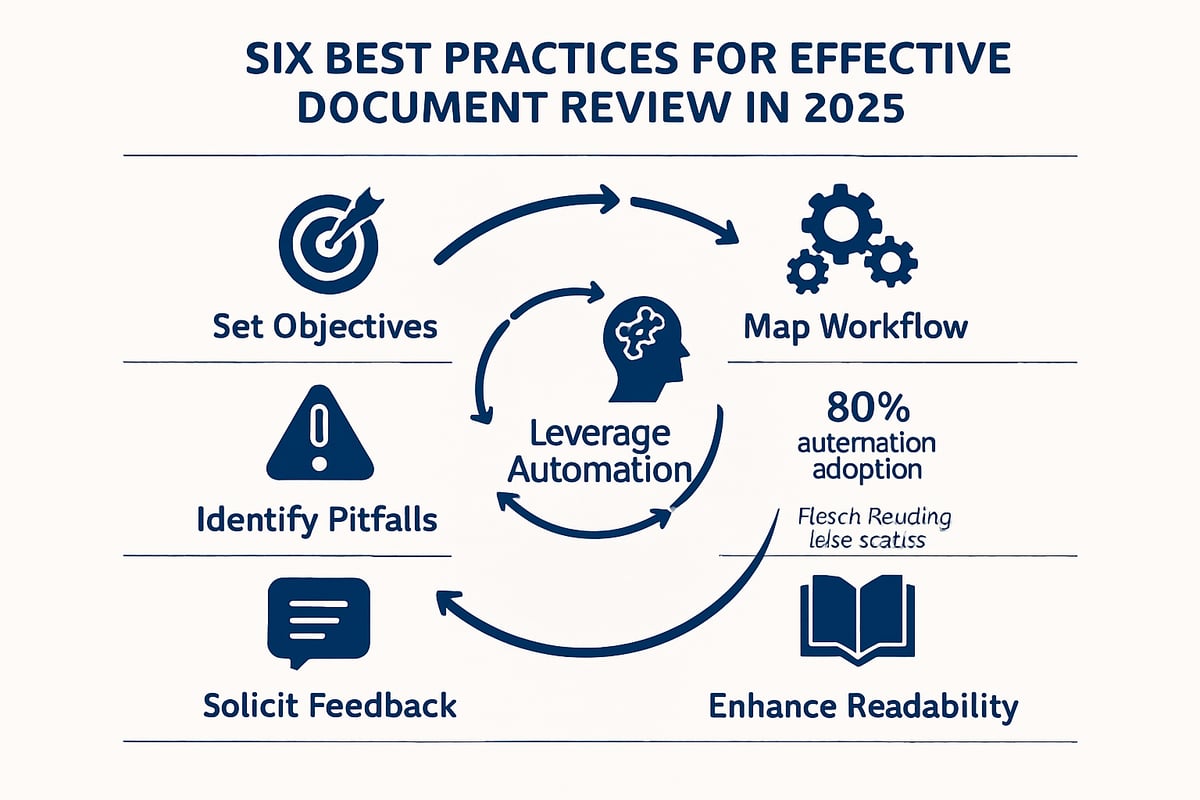
Establishing Clear Review Objectives
Every review document process should start with well-defined objectives. Set specific criteria for accuracy, clarity, and compliance before the first draft is even created. This ensures everyone involved knows the standards the document must meet.
For example, internal training materials may prioritize instructional clarity, while customer-facing documents demand polished language and brand consistency. Align your objectives with business goals and the needs of your end users.
Use checklists or a requirements table to guide reviewers:
| Objective | Internal Docs | Customer-Facing Docs |
|---|---|---|
| Accuracy | High | Critical |
| Clarity | Moderate | High |
| Compliance | As needed | Required |
By setting expectations early, you empower teams to review document content with purpose and direction.
Building a Multi-Level Review Workflow
A robust review document workflow involves multiple stages and clearly assigned roles. Design your process so each stage addresses a different aspect—content accuracy, technical detail, editorial style, and compliance.
Assign reviewers for each checkpoint: the original writer, a peer, a subject matter expert, an editor, and a compliance officer. For example, Document360’s five-level peer review system highlights the benefits of structured collaboration.
Benefits of a multi-level workflow:
- Improved accountability and transparency
- Faster turnaround through defined responsibilities
- Clear audit trail for compliance
When you build a multi-level workflow, your team can review document drafts more efficiently and with fewer errors.
Leveraging Technology and Automation
Modern review document workflows are powered by advanced technology. AI-driven tools now handle grammar checking, readability scoring, compliance validation, and feedback management.
Platforms automate reminders, track changes, and centralize feedback, freeing up teams for higher-level analysis. According to industry trends, 80% of organizations plan to increase automation in their review document processes.
For a deeper look at how AI transforms document review, see Introducing OdysseyGPT for document review. This solution streamlines collaboration, surfaces actionable insights, and accelerates approvals.
Embracing automation means your review document workflow becomes smarter, faster, and more reliable.
Ensuring Accessibility and Readability
A successful review document process guarantees accessibility and readability for all users. Apply Flesch Reading Ease and similar metrics to ensure your content is understandable. Use plain language, especially for compliance documents and terms of service.
Consider visual aids—tables, icons, and clear formatting—to make information easy to digest. For example, sites like ToS;DR grade terms of service for clarity, pushing organizations to simplify complex content.
Checklist for accessibility:
- Use simple sentence structures
- Provide alternative text for images
- Test documents with screen readers
Prioritizing readability in your review document workflow reduces confusion and increases user trust.
Continuous Improvement Through Feedback
Feedback is the engine of every effective review document cycle. Collect input from all reviewers and—crucially—from end users after publication. Analyze this data to identify patterns and areas for improvement.
Iterate on your style guides and review processes regularly. Post-publication surveys and analytics can reveal how well users understand and engage with your documents.
Track metrics such as error rates, approval times, and user satisfaction. By closing the feedback loop, you create a review document process that evolves and improves over time.
Avoiding Common Pitfalls in Document Review
Even the best review document processes can falter if common pitfalls are ignored. Stay vigilant about compliance updates—regulations change quickly, and outdated policies introduce legal risks.
Don’t overlook user feedback or real-world usage issues. Ignoring these can lead to miscommunication and missed business goals.
Strategies to avoid pitfalls:
- Schedule regular compliance audits
- Update templates and checklists frequently
- Communicate changes to all stakeholders promptly
By proactively addressing these challenges, you ensure your review document workflow remains resilient, relevant, and effective.
Roles and Responsibilities in the Modern Review Process
Modern organizations depend on a well-structured review document process to ensure every piece of content meets quality, compliance, and business standards. The clarity of roles and responsibilities is the backbone of efficient document review, preventing miscommunication and delays.
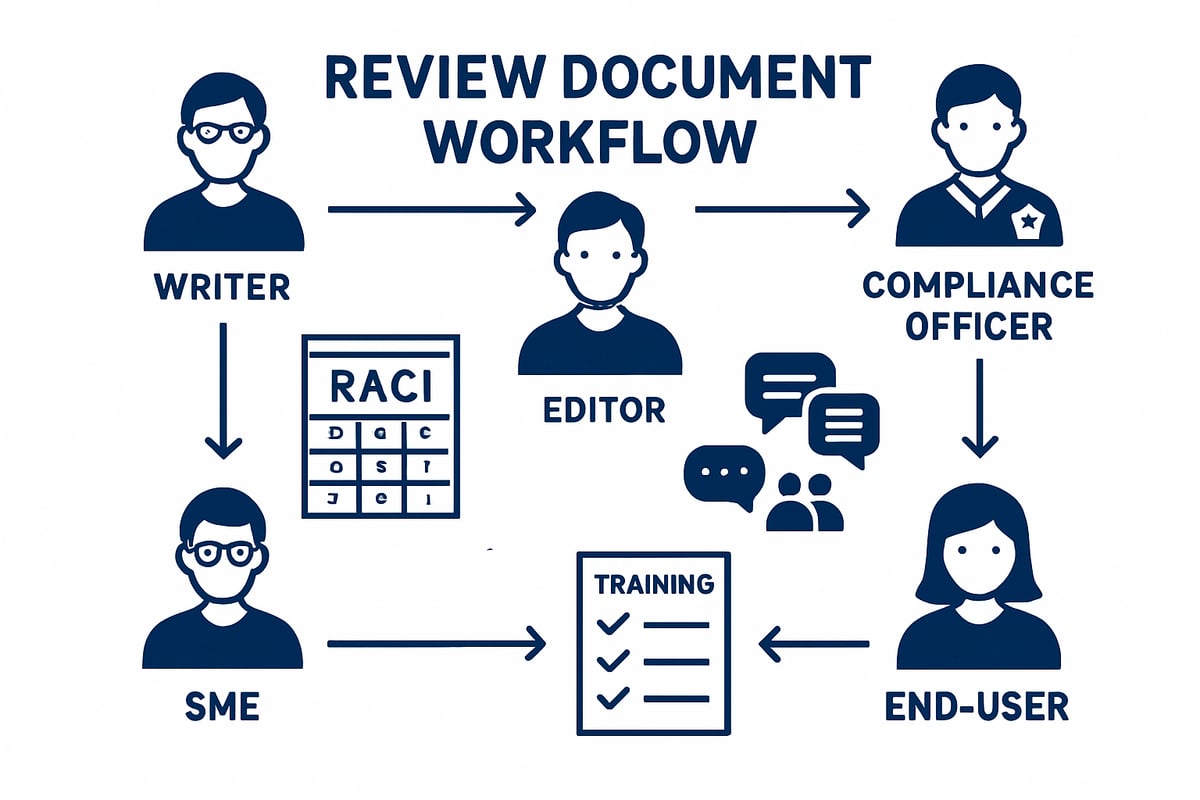
Identifying Key Stakeholders
A successful review document workflow starts by identifying all relevant stakeholders. Writers are responsible for initial content creation, while editors refine tone, grammar, and structure. Subject matter experts (SMEs) validate technical accuracy, and compliance officers ensure regulatory alignment.
In many industries, end-users and support teams also contribute valuable feedback, especially for user-facing documents. For example, a SaaS company may include developers, product managers, and customer support in the review document process to capture multiple perspectives. This cross-functional approach fosters comprehensive quality assurance.
To streamline stakeholder engagement and workflow audits, organizations can adopt strategies outlined in 9 Document Management Best Practices for 2025.
Defining Reviewer Roles and Expectations
Assigning clear roles and expectations is essential for every review document cycle. Use frameworks like RACI (Responsible, Accountable, Consulted, Informed) to clarify who does what and when. Writers are usually responsible for content accuracy, while editors focus on style and readability.
SMEs are consulted for technical validation, and compliance officers are accountable for regulatory checks. Setting deadlines and using digital checklists helps maintain momentum. For instance, in a review document workflow, the editor might flag complex terms for SME review, ensuring accuracy before compliance review.
A transparent process prevents overlap and missed steps. Documenting reviewer expectations reduces confusion and accelerates approvals.
Fostering Effective Collaboration and Communication
Efficient review document processes rely on seamless collaboration. Modern teams use tools that support real-time comments, tracked changes, and discussion threads. Platforms like Document360 and Bynder offer workflow features that centralize feedback and keep everyone aligned.
Regular review meetings and feedback sessions further enhance communication, helping teams resolve ambiguities quickly. Setting guidelines for constructive feedback encourages a positive review environment.
Consider a scenario where a technical writer and an SME discuss API documentation changes live, making the review document process more dynamic and responsive. Clear communication channels reduce bottlenecks and ensure every voice is heard.
Training and Supporting Reviewers
Ongoing training is vital to uphold standards in the review document process. Provide reviewers with up-to-date style guides, compliance requirements, and tool tutorials. Onboarding new team members using checklists and best practice guides builds confidence and consistency.
Encourage a culture of continuous learning by offering refresher courses and peer mentoring. For example, after each major release, conduct a workshop to review document feedback trends and update processes accordingly.
Supporting reviewers with clear resources and open communication channels ensures quality and fosters engagement throughout every stage of document review.
Tools and Technologies Shaping Document Review in 2025
The landscape for review document processes is rapidly evolving, driven by cutting-edge technologies and automation. In 2025, organizations are leveraging a diverse ecosystem of tools to enhance accuracy, collaboration, and efficiency. Let’s explore the platforms and innovations shaping how teams review document content today.
AI-Powered Review Platforms
AI-powered solutions are at the forefront of the review document revolution. These platforms use natural language processing, machine learning, and advanced analytics to streamline feedback, detect inconsistencies, and automate error detection.
Popular features include:
- Automated grammar and style checks
- Semantic analysis for content accuracy
- Conversational querying to extract insights
For a comprehensive comparison of market leaders, see the Top AI Tools for Document Review in 2025, which highlights platforms specializing in deep learning and multi-stage review document workflows.
AI is enabling reviewers to process complex documents faster, reducing human error, and improving compliance outcomes.
Workflow and Collaboration Solutions
Efficient workflow management is crucial for any organization aiming to review document content at scale. Modern platforms offer intuitive dashboards, automated approval routing, and real-time collaboration features.
Key benefits include:
- Transparent tracking of each review document stage
- Role-based assignments and notifications
- Centralized comment threads for feedback
Leading solutions like Bynder’s Content Workflow and Document360’s workflow designer minimize skipped steps and foster accountability. Teams can easily visualize progress, ensuring no review document is left behind in the process.
Readability and Compliance Checkers
Ensuring every review document meets readability and legal standards is now a baseline requirement. Automated tools assess Flesch Reading Ease, check for grammar, and flag compliance risks.
Consider these advantages:
- Instant readability scores for user comprehension
- Automated grammar and spelling corrections
- Integrated compliance checklists for regulations like GDPR
A recent industry statistic shows that 90% of reviewed documents now undergo automated readability checks, underscoring the importance of these tools in the modern review document workflow.
Version Control and Feedback Management
Maintaining control over every review document version is vital, especially in regulated industries. Modern systems provide robust versioning, audit trails, and feedback management, making it easy to track changes and revert if necessary.
Essential features include:
- Automatic version history with time-stamped edits
- Centralized feedback repositories for all reviewers
- Secure archiving for compliance and future reference
Cloud-based review document platforms empower teams to collaborate confidently, knowing every change is documented and recoverable.
Integrating Conversational Document AI (if relevant)
Conversational document AI, such as OdysseyGPT, is redefining how professionals review document content. These tools allow users to interact with documents via natural language, extract structured data, and summarize complex information instantly.
OdysseyGPT stands out with:
- Advanced reasoning and cross-document analysis
- Secure sharing of extracted insights
- Support for legal, business, and academic review document needs
To discover more about the role of AI in transforming document analysis, check out the Top 11 AI Tools for Document Analysis in 2025. Conversational AI accelerates review document processes, fostering collaboration and precision.
Compliance, Security, and Ethical Considerations
Staying ahead in the review document process means addressing compliance, security, and ethical challenges head-on. In 2025, organizations must adapt rapidly to an evolving regulatory landscape, protect sensitive data, and foster trust through ethical review practices. Let’s break down the essentials for a robust approach.
Navigating Evolving Regulatory Standards
The regulatory environment for any review document is complex and constantly changing. New laws like GDPR, CCPA, and the U.S. Plain Writing Act require organizations to maintain transparency, privacy, and clarity in every document.
Global businesses must monitor legal updates across regions. For example, the Plain Writing Act mandates clear, accessible language in federal communications, raising the bar for all sectors. Teams should establish a system for tracking regulatory changes and updating procedures regularly.
A practical approach includes:
- Subscribing to legal update newsletters
- Assigning compliance leads for each region
- Using checklists for required disclosures
For deeper insight into digital standards that impact clarity and usability, see this overview on Core web vitals for B2B documentation.
Ensuring Document Security and Confidentiality
A secure review document process is essential for safeguarding sensitive information. Data breaches or unauthorized access can result in legal penalties and loss of trust. Modern review platforms now offer end-to-end encryption and role-based permissions to restrict access.
Key security practices include:
- Limiting document access to approved reviewers only
- Employing encryption for data at rest and in transit
- Using platforms with detailed access logs
Cloud-based review document solutions often provide audit trails and automated alerts for unusual activity. This proactive stance helps prevent accidental leaks and supports compliance with industry standards.
Ethical Review Practices
Ethics play a critical role in every review document workflow. Addressing bias, ensuring inclusivity, and making content accessible to all users are now non-negotiable. Reviewers should check that language is neutral, respectful, and understandable for diverse audiences.
Consider these ethical guidelines:
- Use inclusive, plain language
- Avoid jargon unless necessary and defined
- Ensure accessibility for users with disabilities
It’s also vital to handle reviewer feedback with respect and maintain transparency throughout the process. Ethical review document practices not only reduce risk but also strengthen brand reputation and user trust.
Audit Trails and Documentation for Compliance
Maintaining accurate audit trails is a cornerstone of any effective review document process. Audit logs should capture each review stage, feedback provided, and final approvals. This documentation is crucial for regulatory audits and legal defensibility.
Best-in-class document management systems automate this process, creating timestamped records of all actions. Features to look for include:
- Automated version histories
- Permission-based approval tracking
- Exportable compliance reports
By keeping thorough records, organizations can demonstrate adherence to regulations and respond quickly to compliance inquiries. This approach ensures the review document process remains transparent, accountable, and ready for scrutiny.
If you’re ready to take your document review process to the next level, now is the perfect moment to put these best practices into action. Imagine having the power to interact with your files conversationally, extract key data instantly, and streamline every step of your workflow—all with greater accuracy and efficiency. That’s exactly what OdysseyGPT offers. Designed for professionals who demand clarity and compliance, OdysseyGPT transforms static documents into living knowledge bases. Why not experience firsthand how AI-driven insights can elevate your review process? You can start free trial today and see the difference for yourself.

